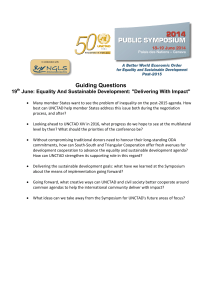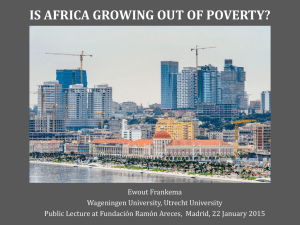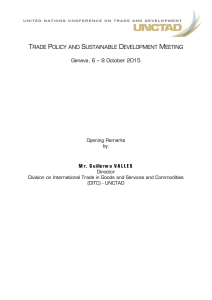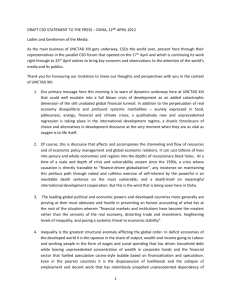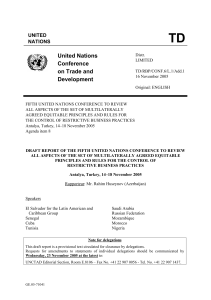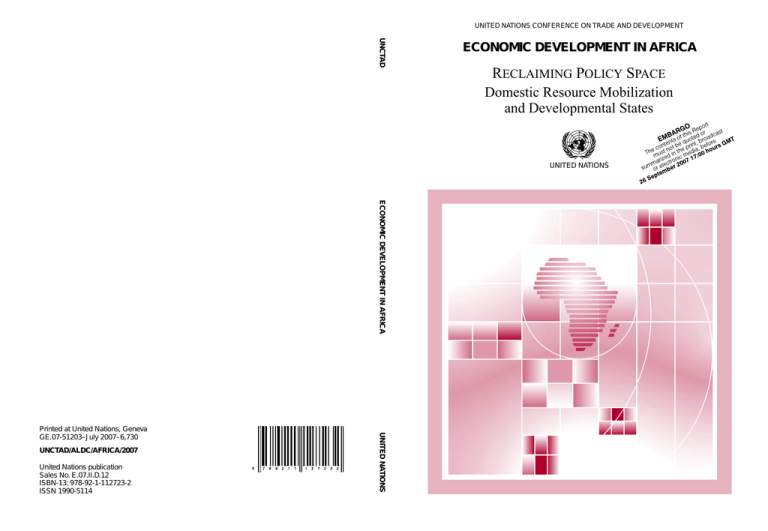
UNITED NATIONS CONFERENCE ON TRADE AND DEVELOPMENT
UNCTAD
ECONOMIC DEVELOPMENT IN AFRICA
RECLAIMING POLICY SPACE
Domestic Resource Mobilization
and Developmental States
UNITED NATIONS
ECONOMIC DEVELOPMENT IN AFRICA
UNCTAD/ALDC/AFRICA/2007
United Nations publication
Sales No. E.07.II.D.12
ISBN-13: 978-92-1-112723-2
ISSN 1990-5114
UNITED NATIONS
Printed at United Nations, Geneva
GE.07-51203–July 2007–6,730
UNITED NATIONS CONFERENCE ON TRADE AND DEVELOPMENT
Geneva
Economic Development
in Africa
Reclaiming Policy Space
Domestic Resource Mobilization
and Developmental States
UNITED NATIONS
New York and Geneva, 2007
ii
Economic Development in Africa: Reclaiming Policy Space
NOTE
Symbols of United Nations documents are composed of capital letters
combined with figures. Mention of such a symbol indicates a reference to a
United Nations document.
The designations employed and the presentation of the material in this
publication do not imply the expression of any opinion whatsoever on the
part of the Secretariat of the United Nations concerning the legal status of
any country, territory, city or area, or of its authorities, or concerning the
delimitation of its frontiers or boundaries.
Material in this publication may be freely quoted or reprinted, but
a­ cknowledgement is requested, together with a reference to the document
number. A copy of the publication containing the quotation or reprint
should be sent to the UNCTAD secretariat.
UNCTAD/ALDC/AFRICA/2007/1
UNCTAD/ALDC/AFRICA/2007
UNITED NATIONS PUBLICATION
Sales No. E.07.II.D.12
ISBN 978-92-1-112723-2
ISSN 1990–5114
Copyright © United Nations, 2007
All rights reserved
Domestic Resource Mobilization and Developmental States
iii
iii
ACKnOWLEDGEMEnTS
This year’s Economic Development in Africa report was prepared by a
research team consisting of Samuel Gayi (team leader), Janvier Nkurunziza,
Martin Halle and Shigehisa Kasahara. The first chapter drew upon the concept
paper “Mobilizing non debt generating foreign and domestic resources for
achieving the MDGs in Africa”, prepared by Martin Brownbridge for an UNCTAD
project on the same issue funded by the United Nations Development Account
(fifth tranche). Detailed comments were received from Kamran Kousari and
Martin Brownbridge on all the chapters, and from Chandra Patel on the policy
conclusions. Diana Barrowclough reviewed the manuscript.
Statistical assistance was provided by a team from the Central Statistics and
Information Retrieval Branch of the Division on Globalization and Development
Strategies, UNCTAD, led by Flavine Creppy under the overall supervision of
Henri Laurencin, Head, Central Statistics and Information Retrieval Branch.
The work was completed under the overall supervision of Habib Ouane,
Director, Division for Africa, Least Developed Countries and Special Programmes
in UNCTAD.
Heather Wicks provided secretarial support. Diego Oyarzun–Reyes designed
the cover, and Michael Gibson edited the text. The overall layout, graphics and
desktop publishing were done by Madasamyraja Rajalingam.
iv
Economic Development in Africa: Reclaiming Policy Space
COnTEnTS
Explanatory notes . .......................................................................................... vi
Abbreviations................................................................................................... vi
Introduction................................................................................................... 1
Chapter 1 .
Domestic Resource Mobilization: Issues at Stake................................................ 6
A.
B.
C.
D.
E.
F.
G.
H.
I.
Domestic resources................................................................................ 6
Trends in savings..................................................................................... 7
Household savings................................................................................ 10
Corporate savings................................................................................. 14
Public sector revenue: taxation............................................................. 16
Financial markets and intermediation................................................... 19
Workers’ remittances............................................................................ 25
Capital flight......................................................................................... 29
Conclusion........................................................................................... 31
Chapter 2 .
The Challenge of Increasing Savings and Boosting Productive Investment. ....... 33
A. Introduction......................................................................................... 33
B. Increasing savings................................................................................. 34
C. Credit constraints................................................................................. 41
D. Barriers to investment in Africa............................................................. 46
E. Effect of business environment on gross domestic capital formation...... 53
Chapter 3.
Towards a “Developmental State”................................................................... 57
A.
B.
C.
D.
Introduction......................................................................................... 57
The developmental State: concept and characteristics.......................... 58
Financial sector reforms: curbing government intervention
to cure “financial repression”................................................................ 65
Can Africa nurture “developmental States”?.......................................... 74
Domestic Resource Mobilization and Developmental States
E. “Policy space” – what to do with it?...................................................... 84
F. Concluding remarks.............................................................................. 87
Chapter 4.
Reclaiming and Utilizing Policy Space. ............................................................ 89
A. Mobilizing domestic savings.................................................................. 90
B. Developing credit markets and boosting productive investments........... 93
C. Delivering appropriate financial and investment policies:
the need for a “developmental State”................................................... 95
Notes . .......................................................................................................... 99.
References ................................................................................................... 106
LIST OF BOXES
1. Newly industrializing economies: dynamics of capital accumulation,
export–investment nexus and rent management....................................... 62
2. The role of central banks in development................................................. 68
LIST OF FIGURES
1. Gross domestic savings in sub-Saharan Africa, 1960–2005.......................... 8
2. Gross domestic savings by developing regions, 1960–2004......................... 9
3. Selected indicators of financial depth and financial intermediation........... 20
4. Capital flows to Africa, 1985–2005........................................................... 27
5. Capital formation vs. business environment............................................... 54
LIST OF TabLES
1. Distribution of savings rates in Africa, 2000–2005....................................... 8
2. Regional comparative data on the cost of doing business.......................... 46
3. Gross national savings, gross domestic investment and exports
in the Asian NIEs and Africa, 1971–2005.................................................. 64
4. Mind the technology gap: East Asia and Africa.......................................... 66
5. Per capita GDP growth rates: top 50 developing countries, 1960–1975........ 79
6. Economic performance by period and region............................................ 81
vi
Economic Development in Africa: Reclaiming Policy Space
EXPLanaTORY nOTES
The $ sign refers to the United States dollar.
Sub-Saharan Africa (SSA): Except where otherwise stated, this includes South
Africa.
North Africa: Unlike in the UNCTAD Handbook of Statistics, in this publication
Sudan is classified as part of sub-Saharan Africa, not North Africa.
AbbREVIaTIOnS
APRM
African Peer Review Mechanism
FDI
foreign direct investment
GATT
General Agreement on Tariffs and Trade
GDP
gross domestic product
GERD
gross expenditure on research and development
GNI
gross national income
ICT
information and communication technology
IMF
International Monetary Fund
ISI
import substituting industrialization
MDGs
Millennium Development Goals
NEPAD
New Partnership for Africa’s Development
NIEs
newly industrializing economies
ODA
official development assistance
OECD
Organization for Economic Cooperation and Development
REI
rigidity of employment index
SAP
structural adjustment programme
WTO
World Trade Organization
Domestic Resource Mobilization and Developmental States
InTRODUCTIOn
One of the most prominent objectives of the Millennium Development Goals
(MDGs) adopted at the United Nations Millennium Summit in 2000 was to
have member States halve their levels of absolute poverty by 2015. While some
regions of the developing world have made sufficient progress towards achieving
this goal, sub‑Saharan Africa has been singled out as one region that is unlikely
to meet the target by 2015 if current trends continue. Indeed, halfway through
to the target year, the latest data on poverty shows that sub-Saharan Africa is the
only developing region where the absolute number of poor people has been
steadily increasing, even if the relative number declined from 47 per cent to 41
per cent of the total population between 1999 and 2004 (Chen and Ravaillon,
2007). One of the reasons why sub‑Saharan Africa might miss the 2015 target
is its relatively low rate of economic growth. Indeed, despite the recent gains
made by a number of countries in terms of export revenue, thanks to high prices
of some major primary commodities, the growth rate in sub‑Saharan Africa as a
region continues to fall short of the 7–8 per cent necessary to achieve the MDGs
target on halving poverty.
To raise the growth rate and sustain it at the level that will allow African countries
to halve poverty by 2015 requires a significant increase in the volume of foreign
and domestic resources devoted to promoting overall development in general,
and poverty reduction programmes in particular. There have been numerous
international initiatives aimed at increasing the volume of official development
assistance (ODA) and its grant element to poor countries.1 However, donors are
not on course to meet these pledges (OXFAM, 2007; The Economist, 2007), and
the overall effect of these resources on poverty reduction has remained marginal.
The limited development effectiveness of ODA has been partly associated with
the inefficiency in the use of aid, which has resulted in relatively small amounts
effectively used for development purposes (UNCTAD, 2006a). Foreign direct
investment (FDI) flows to Africa, though on the increase in recent years, are still
too limited in geographical coverage and focused on extractive industries to have
a significant effect on employment creation and poverty alleviation (UNCTAD,
2005). In this regard, harnessing domestic financial resources could help raise
additional financing in order to narrow Africa’s resource gap and accelerate the
process of economic development and poverty reduction. Moreover, reducing
dependence on donor funds and associated conditionalities would increase
“ownership” of the development process whereby these resources could be
used to fund countries’ own priorities rather than those of the donors.
Economic Development in Africa: Reclaiming Policy Space
There are several potential sources of domestic finance that could provide
important additional development resources if they were properly tapped.
However, the policy actions taken so far to increase the total development
resource envelope do not sufficiently recognize that African countries need
to step up their efforts at enhancing domestic resource mobilization. Firstly,
some public finance reforms have been implemented to increase government
revenue, but they have been limited to basic issues such as the introduction of
broad-based consumption taxes, mainly in the form of value added tax. The
effect on government revenue has remained limited. Secondly, little effort has
been made to mobilize workers’ remittances, a major external resource for a
number of African countries. Currently, the flows of remittances largely bypass
the banking system. They are channeled into consumption and, to some extent,
real estate development, with little positive impact on development. Thirdly,
there have been no concerted efforts to tap investible resources from the large
and vibrant informal sector in African countries. Fourthly, capital flight continues
to deny African economies large amounts of the continent’s own resources
that could have funded domestic investments that create jobs and provide or
boost incomes of the large segments of the population that are unemployed
or underemployed. Fifthly, the reforms in the financial sector have focused on
interest rate liberalization and the dismantling of entry barriers in the banking
sector to increase competition in order to improve the quality of financial
intermediation. So far, the results have been mixed.
Africa’s financial resources needs
African economies have been enjoying a period of relatively strong economic
performance over the past few years. This is an encouraging change from the
previous decades, when economic performance was either negative or stagnating.
The growth rate for the continent was 5.7 per cent in 2006, exceeding even
the record rates of 5.3 per cent in 2005 and 5.2 per cent in 2004 (UNECA,
2007). The sub-Saharan African region, meanwhile, recorded a per capita gross
domestic product (GDP) growth rate of 3.4 per cent in 2005, the highest since
1974 (World Bank, 2007a). This impressive performance is principally due to
rising prices for primary commodities, benefits from macroeconomic stability
and reform, substantial inflows of external financing and debt relief (UNECA,
2007).
Domestic Resource Mobilization and Developmental States
Despite strong macroeconomic performance since the turn of the century,
the growth rates achieved are still insufficient for the continent to achieve the
objectives of the MDGs by the target date of 2015. From 1998 to 2006, only
five countries in Africa (Angola, Chad, Equatorial Guinea, Mozambique and
Sudan) grew at 7–8 per cent growth rates necessary for halving poverty (UNECA,
2007). Additionally, although the region as a whole has enjoyed good economic
performance in recent years, growth rates remain dependent on a small number
of primary commodities and high average growth rates mask large differences
in performance across the region. Furthermore, recent economic growth has
not translated into corresponding increases in employment, and the limited job
creation that has taken place has mainly been in the informal sector, due to
the capital-intensive and enclave nature of the extractive sectors that have been
driving this growth (UNCTAD, 2005; ILO, 2007). This phenomenon of “jobless
growth” is a major preoccupation of African Ministers of Finance, Planning and
Economic Development, as expressed in Abuja in 2005 (UNECA, 2005b).
Policy choices, political stability and the external environment all play crucial
roles in defining the economic performance of African countries. Regardless of
the situation, however, the availability of resources for socially and economically
productive investment will be a necessary condition for a more balanced growth
trajectory based on economic diversification (UNCTAD, 2003) and employment
creation. Current resources are neither sufficient nor stable enough to allow the
region to fully attain the first Millennium Development Goal by 2015 (UNCTAD,
2000a; UNCTAD, 2005; UNCTAD, 2006a; UNECA, 2006).
Estimating the cost in resources of achieving the MDGs is necessarily
a speculative exercise. These estimates do, however, point to the order of
magnitude of the existing resource gap. It is believed that, across all developing
countries, an additional $50 billion to $76 billion per year is needed to reach
the MDGs. In Africa, the need for additional resources is generally believed to
amount to between 10 and 20 per cent of GDP (UNECA, 2005a; UNECA, 2006;
see UNCTAD, 2006a for more information on cost estimates).
UNCTAD estimated in 2000 that investment rates needed to reach 22–25
per cent in order to increase sustainable growth rates to 6 per cent (UNCTAD,
2000a). From 2000 to 2004, sub-Saharan Africa averaged investment rates of
only 18.1 per cent of GDP, while the figure for all of Africa was 20.7 per cent.
Explanations for these low rates tend to highlight the low savings rates as well
Economic Development in Africa: Reclaiming Policy Space
as the lack of profitable investment opportunities. Only seven countries in subSaharan Africa (Botswana, Chad, Eritrea, Gabon, Lesotho, Mozambique, and
Sao Tome and Principe) achieved investment rates above 25 per cent of GDP. In
North Africa, however, investment rates were notably higher, averaging 25.6 per
cent (World Bank, 2006).
The resource gap in Africa must be bridged using both external and domestic
resources. There are, however, a number of problems related to excessive
dependence on foreign capital flows (see UNCTAD, 2005; UNCTAD, 2006a).
Strengthening of domestic resource mobilization, combined with improvements
in the efficiency and efficacy in the use of such resources, will not only reduce
or eliminate the resource gap. It will also increase the “policy space” available
to the State to enable it to define its development goals and the means to attain
them.
The objective of this year’s report is to examine the potential of African
countries to increase their total domestic resource envelope in order to
reduce dependence on external resources, namely ODA, and diversify their
development resources. Channelling these resources to productive investments
to increase their efficiency is a complementary objective. To achieve these aims,
the State will have to assume its role as a “developmental State”, a concept that
this report intends to bring back to centre stage (see chapter 3 for a discussion
of this concept). Indeed, the African State must reclaim its developmental role
in order to give true meaning to the rhetoric of “ownership” in macroeconomic
and resource management.
Of course, resource mobilization will not by itself solve all the problems
faced by African countries, particularly considering that many of them lack
the institutions and human resources necessary to make development work.
However, in the medium to long term, the ability of African countries to finance
an increasing share of their development needs from domestic sources would
give them much-needed flexibility in the formulation and implementation of
policies that address their economic, social and other developmental challenges.
The multiplicity of the challenges facing Africa inevitably calls for an appropriate
“policy mix” or “diversity of policies” tailored to the specific situation of each
country, rather than a one-size-fits-all approach. In this context, the report
highlights the need for more policy space for African countries to design and
implement policies that make optimal use of available resources in a way that
Domestic Resource Mobilization and Developmental States
leads to a virtuous circle of accumulation, investment, growth and poverty
reduction drawing on the model of developmental States.
Chapter 1 is a brief exposé of the salient issues involved in domestic resource
mobilization within the context of African countries. Chapter 2 examines the
challenges involved in raising the level of savings in Africa and discusses how
the savings raised could be used to finance productive investments as a basis for
sustainable growth. Chapter 3 delineates the characteristics of “developmental
States” while examining their applicability to Africa. It argues that the necessary
conditions are currently in place for African countries to tackle their developmental
challenges within the framework of a “developmental State”. Chapter 4, the
final chapter, distils some policy conclusions from the preceding discussions.

